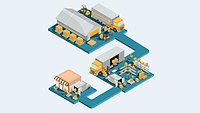Barriers to WGS Implementation Around the World

Whole genome sequencing (WGS) is a scientific tool that is often used for food safety investigations and foodborne illness surveillance within North America and Europe. A recent survey, however, found that only 8 percent of laboratories outside of North America and Europe use WGS for routine, real-time surveillance. One third of respondents reported not using WGS at all. The study was led by PulseNet International (PNI), a global network of 88 countries that seeks to implement WGS worldwide.
According to the World Health Organization (WHO), WGS costs 1.2–4.3 times more than traditional molecular methods. Aside from the cost, however, significant organizational, cultural, technical, and scientific barriers to adopting WGS exist. The survey found an array of obstacles to WGS implementation, such as critical gaps in expertise and bioinformatics, struggles to share sequence data with public repositories, a lack of cluster detection and outbreak response tools for countries that are less able to share outside their jurisdiction, and a dearth of tools that can be used with all sequencing platforms.
The qualitative survey represents the 2019 calendar year and was distributed to 54 PNI-participating nations in Africa, Asia-Pacific, Latin America and the Caribbean, and the Middle East. Of the countries that were invited to participate in the survey, 41 laboratories from 33 nations completed the questionnaire. The majority of laboratories that responded (66 percent) were national reference laboratories, followed by the academic and research sector (24 percent), and laboratories that could not be categorized (10 percent). Notable data from the laboratories’ responses include:
- 8 percent use WGS for routine foodborne illness surveillance, 20 percent use WGS after an outbreak is identified by other means, and 28 percent use WGS exclusively for research and pilot studies
- Of the laboratories that do not use WGS, 40 percent outsource WGS to another institution, 47 percent plan to implement WGS by 2022, and 27 percent plan to implement WGS after 2022
- 61 percent of respondents indicated that their capacities for utilizing, optimizing, and troubleshooting wet lab protocols for WGS were good to excellent
- Only 28 percent of laboratories reported having access to high-performance computing
- 44 percent of responses characterized their laboratories' capacity and expertise to utilize, develop, optimize, and troubleshoot bioinformatics analysis protocols for WGS data as little or none
- 61 percent of laboratories do not have established guidelines for interpreting WGS data, and 21 percent rely on interpretation criteria developed by others or found in literature
- Only 33 percent of laboratories characterized their level of knowledge and ability to utilize WGS data for public health decision-making as good to excellent, while 19 indicated their capacity to do so was moderate, and 48 percent categorized it as minimal or nonexistent
- Only 18 percent of laboratories use modern means, such as information management systems or internal bespoke websites, to communicate subtyping results for outbreak and detection to stakeholders, while 32 percent use excel sheets, 24 percent use hard copies and fax, 18 percent use in-person or telephone, and 9 percent use formal written reports and manuscripts
- 56 percent of laboratories do not exchange sequence data with external partners within their country, and 58 percent of laboratories reported rarely or never identifying genetic matches in other countries
- Only 22 percent of laboratories routinely make their sequencing data publicly available, with 50 percent being unaware for the reasoning behind not doing so, 21 percent having not considered doing so, 18 percent experiencing a lack of time and personnel, 14 percent having concerns of personal data protection and privacy, and 11 percent being legally restricted from doing so
- 78 percent of laboratories identified funding as a top barrier to WGS, followed by gaps in expertise (61 percent), training (56 percent), and staffing (31 percent).
The survey’s findings suggest that the capacity for generating sequences is generally higher than the capacity for analyzing or interpreting the data, that end-user knowledge for effective use of WGS data is low, that the dissemination of WGS results is largely achieved through traditional mechanisms, and that data-sharing is highly limited. PNI stresses the critical need to find solutions for a globally standardized, WGS-based surveillance platform and pipelines that are accessible to all members, with or without public sharing.
Looking for a reprint of this article?
From high-res PDFs to custom plaques, order your copy today!







